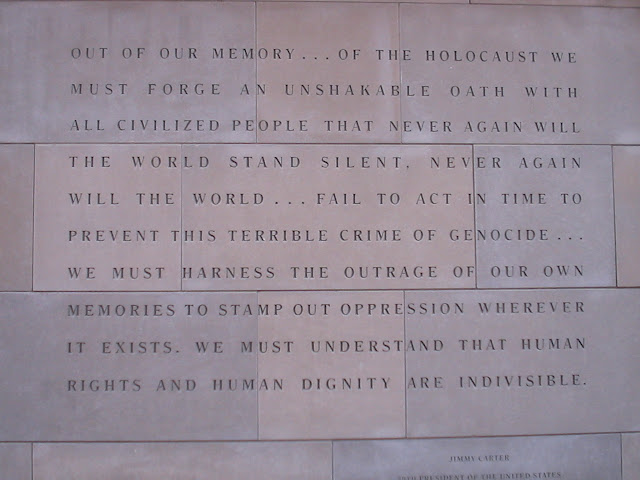It’s difficult to visit anywhere in the world without encountering some form of World War II history. It’s everywhere, from the remnants of bombed churches in Hamburg to the beaches of Normandy and even museums here in the United States.
It’s hard for many of us to understand that time period since it seems so long ago, but these World War II and Holocaust sites are important for travelers of all ages, races, ethnicities and gender to visit.
This post contains affiliate links that can earn this website a small income. They will not cost you anything to use.
Anne Frank House, Amsterdam, The Netherlands
On one of my first independent trips to Europe, I spent a few days in Amsterdam. I, of course, visited the Anne Frank House, climbing the narrow stairway to the “Secret Annex” and seeing the bookcase that hid them from view. It was hard to imagine being trapped inside such a small space with two families for many months. It was her diary, now published in hundreds of languages, that gives a face to the tragedy.
Anne Frank House, Prinsengracht 263-267, 1016 GV Amsterdam, Netherlands, +31 20 556 7105
Dachau Concentration Camp, Munich, Germany
Visiting any one of the remaining concentration camps, including Auschwitz, Bergen-Belsen, Buchenwald and others, is a truly sobering experience, but my visit to Dachau stayed with me long after I was back in central Munich.
Visitors can see the bunks where prisoners slept and the crematorium that held remains at Dachau. Some of the worst brutality of the war and the Holocaust took place at this camp on both the European Jews, Jehovah’s Witnesses, homosexuals, gypsies and political dissidents.
Dachau Concentration Camp, Alte Römerstraße 75, 85221, Dachau, Germany, +49 8131 669970
United States Holocaust Memorial Museum, Washington DC, United States
I visited Washington DC in 2005 as a part of a student leadership conference in international diplomacy. We spent an afternoon at the United States Holocaust Memorial Museum, where what I remember most was the room full of shoes of the victims, all left behind. Other exhibits feature one of the railcars used to transport prisoners to the camps and ultimately their deaths as well as displays on modern genocide.
United States Holocaust Memorial Museum, 100 15th St SW, Washington, DC 20024, (202) 488-0400
Memorial to the Murdered Jews of Europe, Berlin, Germany
During my bike tour through Berlin, we were taken to the Memorial to the Murdered Jews of Europe, an imposing stretch of uneven columns. It remembers the six million Jewish Holocaust victims and is made up of 2,711 stelae. It’s reminiscent of cemeteries throughout Europe with old headstones jutting out and is intended to represent order and reason gone wrong.
Holocaust Memorial, Georgenstraße 23, 10117, Berlin, Germany, +49 3026 39 430
Valor in the Pacific National Monument, Honolulu, Hawaii, United States
The surprise attack by the Japanese on the Americans at Pearl Harbor brought the country into a war it otherwise wasn’t involved in. Bombs dropped on the USS Arizona and throughout the port resulted in over 2,000 American deaths and is known as the “day that will live in infamy.” Visitors can see the remains of the ship underwater and learn more about the war through the interpretive displays.
Pearl Harbor Visitor Center, 1 Arizona Memorial Place, Honolulu, HI 96818, (808) 422-3300
National World War II Museum, New Orleans, Louisiana, United States
A visit to the National World War II Museum in New Orleans wasn’t originally on the itinerary but when I received a VIP pass that gave entry, my friend Marina and I decided to go. I’m glad I did, as it is a fantastic resource for those interested in learning about the war. The Higgins boats used in Normandy were built in New Orleans, so there’s a special local connection to the war.
The National World War II Museum, 945 Magazine St, New Orleans, LA 70130, (504) 528-1944
Further Reading
- Night by Elie Wiesel– This book gives a firsthand account of a teenage boy sent to a Nazi death camp that exterminates his entire family.
- The Diary of a Young Girl by Anne Frank– After her death, her father turned her diary into a book that has been translated into dozens of languages and read in schools worldwide.
- The Boy in the Striped Pajamas by John Boyne– A boy’s father receives a promotion and is sent to oversee a concentration camp. The boy makes a friend, but whose life is very different from his own.
- Number the Stars by Lois Lowry– One of my favorite books as a child tells the lesser known story of the evacuation of Danish Jews. A young girl named Annemarie hides her best friend to protect her from being sent to a concentration camp.

Leave a Reply